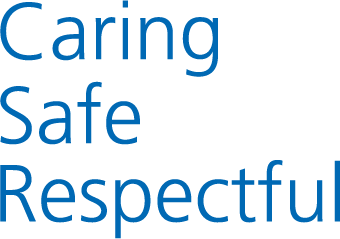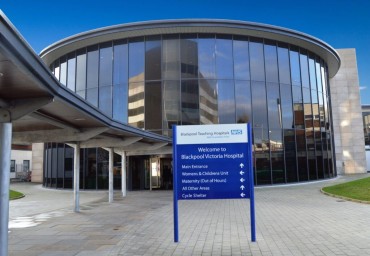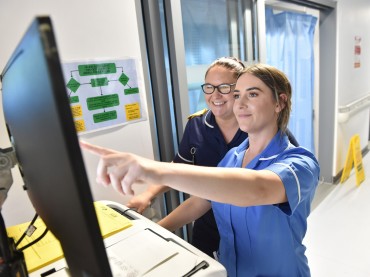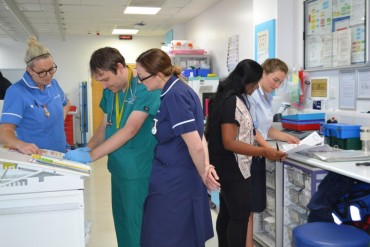I've arrived - what happens next?
You will now be registered as a new attendance and will wait to be triaged. We try to keep this initial wait as short as possible (aiming for 15 minutes) but this will depend on how many other patients have arrived at a similar time to you.
Triage is an initial clinical assessment to determine priority. The triage nurse will ask you some initial questions about your illness or injury to decide what clinical priority you are. This in turn will determine how quickly you will be fully assessed. All attendances, including ambulance arrivals are triaged to ensure that patients with the greatest clinical needs are seen first. Your clinical priority will be one of the following:
- Red – critical – immediate intervention required
- Orange – very urgent – should be assessed within 10 minutes of triage
- Yellow – urgent – should be assessed within 1 hour of triage
- Green – standard – should be assessed within 2 hours of triage
- Blue – non-urgent – should be assessed within 4 hours of triage
Depending on what your clinical presentation is, you may be directed to our Urgent Treatment Centre where you will be seen by either a Doctor or an Advanced Nurse Practitioner. UTC is designed to help speed up the management of relatively minor injuries or illnesses and to reduce the risk of you having to wait longer because of the arrival of higher priority patients.
Another pathway following triage may be the Trust’s Same Day Emergency Care unit, which is located on site, in the new Emergency Village building. This unit operates between 8am and midnight, with last referrals for most of the specialities at 9pm.
There are a wide range of specific conditions which can be referred to SDEC with the aim of rapidly assessing patients to perform diagnostics, treatments and procedures on the day and avoid unnecessary admission and long waits in the Emergency Department.
Your clinical assessment will be much more thorough compared to triage and will involve more questioning and an examination. At this stage, your clinician will be working out the cause of your condition and will be forming a plan to best manage it. This plan could range from a simple intervention and some pain relief to investigations that require a longer stay in the Emergency Department.
Common emergency investigations include blood samples, x-rays (or other types of imaging such as ultrasound or CT scans), urine samples and ECGs. The results of these investigations help your clinician decide on the next steps of management. Again, depending on how busy the department is, simple x-rays can take 40 minutes or so to complete and blood samples often can take 60 minutes or so for results to be returned from the laboratory.
We aim to ensure that all patients are seen as soon as possible, but it is very difficult to predict how long you will have to wait. The triage system ensures that patients requiring immediate attention are seen before other patients, whose problem may be distressing, but who are safe to wait for treatment. Waiting times vary and depend on the number of patients waiting, as well as the severity of their conditions. The triage nurse will inform you of approximate waiting times. This information can also be found on the board in the waiting room.
The waiting time may increase suddenly when seriously ill or injured patients arrive or when patients’ conditions worsen which will require immediate attention. We will try to keep you updated of such changes in waiting times. At times, it may appear quiet in the waiting room, but this does not reflect activity within the department. Many unwell patients arrive by ambulance at the side entrance.
For patients who are waiting to see an in-patient specialty team (e.g. Orthopaedics, Medicine, Surgery etc) the waiting time is different and not controlled by the Emergency Department. The same applies if you require admission to a ward and sometimes there may be a considerable delay before you are transferred out of the ED. We will keep you informed on progress of this.
Ultimately, your clinician will decide whether you are safe to discharge home, or whether your condition requires the input of other teams. If you are ‘referred’ you will be assessed by an on-call doctor from one of our in-patient specialties. On-call teams are usually very busy so if they are not available to see you in the Emergency Department, or if your condition definitely requires in-patient care, we will transfer you to a bed on one of the wards.
If you are discharged, we may give you medication or a prescription to go home with. We will let your GP know what medication we’ve given you, just in case you need more.
Your comfort is our concern. Please do not eat or drink before being seen by the Triage nurse. Refreshments are available from the vending machines in the waiting room, the Restaurant and also from catering outlets in the main entrance. ED staff can direct you to these. Toilets are located in the waiting room. Please inform staff if you find them in an unacceptable condition. Baby-changing facilities are available. Please ask one of our staff if you require an area for breastfeeding.
Few discharges from the Emergency Department would prevent you from driving – if you are unsure, please ask us.
The main considerations are broken bones, eye problems or medications that we might have given you that cause drowsiness



